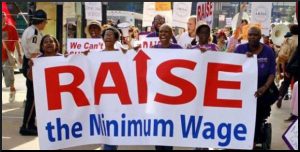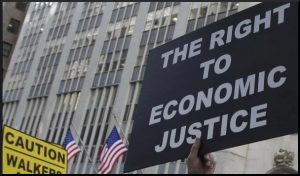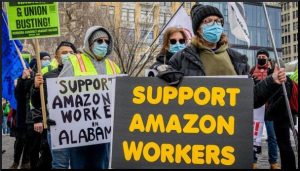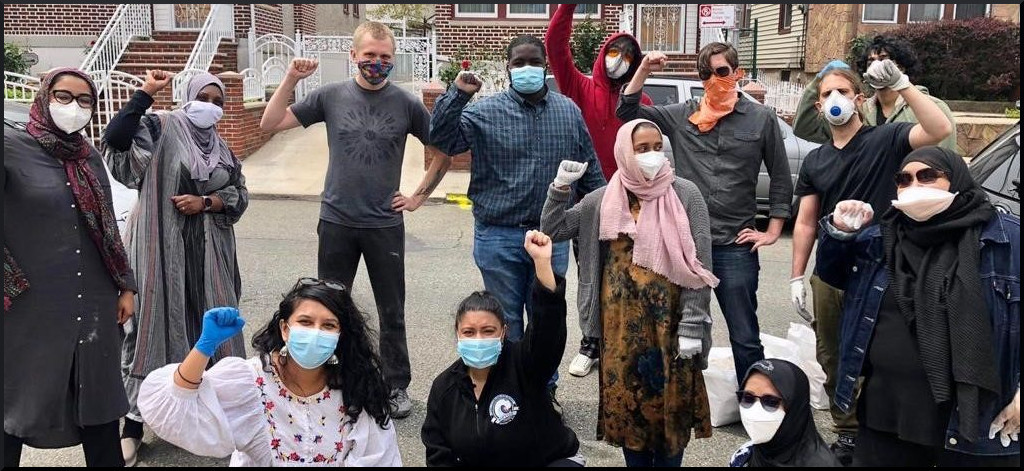by Margaret Flowers, published on Popular Resistance, March 1, 2021
The American Rescue Plan (ARP) was passed in the House this past week and now heads to the Senate, where it will no doubt be changed before it becomes law some time in mid-March. The current unemployment benefits expire on March 14.
While we don’t know what the final bill will look like, at least now we can get an idea of what is in it. Overall, as expected, the provisions in the bill will help to provide some financial assistance to some people, but they won’t solve the crises we face. And the Biden administration is backtracking on promises made on the campaign trail.
As Alan Macleod writes, Biden has abandoned raising the minimum wage, ending student debt and the promised $2,000 checks. His focus is on forcing people back to work and school even as new, more infectious and more lethal variants of the virus causing COVID-19 threaten another surge in cases and deaths. There is only one promise Biden appears to be keeping, and that is one he made to wealthy donors at the start of his campaign when he said, “nothing would fundamentally change.”
 Despite this, people are organizing across the country for their rights to economic security and health and an end to discrimination. These struggles are necessary as we cannot expect either of the capitalist parties to act in the people’s interest. But together, we can demand that one of the wealthiest nations on earth upholds its responsibility to provide the basic necessities for its people. This is consistent with a People(s)-Centered Human Rights approach.
Despite this, people are organizing across the country for their rights to economic security and health and an end to discrimination. These struggles are necessary as we cannot expect either of the capitalist parties to act in the people’s interest. But together, we can demand that one of the wealthiest nations on earth upholds its responsibility to provide the basic necessities for its people. This is consistent with a People(s)-Centered Human Rights approach.
What is and isn’t in the ARP?
The current version of the American Rescue Plan contains provisions that would provide money to people earning less than $75,000 per year. One is the one-time $1,400 check. Another is raising the tax credit for families with children, which will benefit those who file tax returns but leave out the millions of poor people who don’t.
The ARP will also extend unemployment benefits until the end of August and increase the enhanced benefits to $400/week. Unlike the previous bills, this one includes workers who left their jobs because of unsafe conditions and those who had to leave work or reduce their hours to care for children. The benefits are retroactive for some workers who were denied benefits.
While this will temporarily improve the economic situation for many people, it is not a plan to address the poverty crisis in the United States nor is it sufficient to support people through the current recession and pandemic. People will still face barriers to receiving the aid. Instead of making the programs something that people have to apply for, the government could provide monthly checks to everyone with incomes under a certain amount automatically. Numerous examples show that putting money into people’s hands, such as through a guaranteed income or giving unrestricted lump sums, improves their well-being.
An increase in the federal minimum wage to $15/hour, a promise of Joe Biden and the Democratic Party, is in the House version of the bill, but it will not be in the Senate version unless the White House or Democrats intervene, which they seem unwilling to do. The minimum wage increase is being blocked by the Senate Parliamentarian, but the Vice President could override the decision or the Democrats could take steps to work around the Parliamentarian, as has been done in the past on other issues. They are choosing not to take this stand.
The ARP also fails to extend the eviction moratorium, which will expire at the end of March. While it does contain funds for rental assistance, they are being given to the Treasury Department to disburse to the states, so it is not clear how these funds will help people directly. A recent study found that corporate landlords received hundreds of millions of dollars in subsidies and tax breaks last year but continued to evict thousands of people. When the eviction moratorium ends, those who cannot pay the back rent risk being evicted.
The health benefits in the ARP are not only inadequate but they are set to further enrich the medical-industrial complex, as I explain in “Biden’s Health Plan Shifts Even More Public Dollars into Private Hands.” The ARP is fulfilling a laundry list provided by private health insurers, hospitals and medical lobbying groups. It will subsidize the cost of insurance premiums but leave those who have health insurance still struggling to pay out-of-pocket costs and at risk of bankruptcy if they have a serious accident or illness.
 And finally, another group that is being left out is those who have student debt. I spoke with Alan Collinge of Student Loan Justice on Clearing the FOG this week. He said the current student loan burden is likely over $2 trillion and that the vast majority of debtors will never be able to repay . Collinge argues that it is imperative the Biden administration cancel student debt using an executive order, which he has the power to do, rather than leaving it to Congress. If the President does it, then the debt disappears (tax payers have already paid for the loans), but if Congress does it, which is unlikely to happen, they would have to offset the ‘cost’ through cuts to other programs or by raising taxes. Collinge also explains that cancelling student debt would be a significant economic stimulus.
And finally, another group that is being left out is those who have student debt. I spoke with Alan Collinge of Student Loan Justice on Clearing the FOG this week. He said the current student loan burden is likely over $2 trillion and that the vast majority of debtors will never be able to repay . Collinge argues that it is imperative the Biden administration cancel student debt using an executive order, which he has the power to do, rather than leaving it to Congress. If the President does it, then the debt disappears (tax payers have already paid for the loans), but if Congress does it, which is unlikely to happen, they would have to offset the ‘cost’ through cuts to other programs or by raising taxes. Collinge also explains that cancelling student debt would be a significant economic stimulus.
All in all, the current ARP is another attempt by Congress to throw more money at a failed system that doesn’t change anything fundamentally. We must demand more.
The case for wealth redistribution
Lee Camp recently made the case for a massive change in the direction of wealth redistribution based on a new study that finds
“the cumulative tab for our four-decade-long experiment in radical inequality has grown to over $47 trillion from 1975 through 2018. At a recent pace of about $2.5 trillion a year, that number we estimate crossed the $50 trillion mark by early 2020.”
This amounts to over $1,000 per month per person in wealth that has been redistributed to the top or almost $14,000 per year.
It is time to reverse the direction of this wealth redistribution from one of consolidation at the top to one that creates greater wealth equality. This could be accomplished in a number of ways. In the middle of the last century, it was done through extremely high taxes on the wealthy and government investment in programs for housing and education. Camp advocates for taking all wealth over $10 million and redistributing it to the bottom 99.5% in a way that benefits the poorest the most.
Raising wages is another way to redistribute wealth. Professor Richard Wolff explains there are ways to raise wages without harming small businesses by providing federal support to them to offset the costs. Think of it as a reversal of the hundreds of billions in subsidies that have been given to large corporations, which they use to buy up and inflate the value of their stocks, to the small and medium businesses. It is smaller businesses that are most likely to keep wealth in their communities, unlike large corporations that extract wealth, and are the major drivers of the US economy. Small businesses alone comprise 44% of US Gross Domestic Product (GDP).
If workers earned higher wages, it would also save the government money that is currently spent on social safety net programs such as Medicaid and food stamps for low-wage workers. These programs enable large corporations to profit off worker exploitation, especially Walmart, Amazon and McDonalds, according to the DC Report.
Robert Urie points out that another price society pays for the gaping wealth divide is state violence and incarceration. He writes,
“At $24 per hour, the inflation and productivity adjusted minimum wage in the U.S. from 1968, workers were still being added to employer payrolls. The point: $24 – $7.25 = $16.75 per hour plus a rate of profit is one measure of economic expropriation from low wage workers in the U.S. Maintaining an unjust public order is critical to the functioning of this exploitative political economy. Most of the prison population in the U.S. comes from neighborhoods where the minimum wage affects livelihoods.”
Imagine the many ways that greater economic security would positively benefit families and communities.
People are fighting back
In our current political environment, we cannot expect Congress and the White House to do what is necessary to protect the health and security of people without a struggle that forces them to do so. There are many ways people are fighting locally for their rights through resistance and creating alternative systems. Here are a few current examples.
On February 16, fast food workers in 15 cities went on strike to demand $15 an hour. Other low-wage workers joined them. Last Monday, in Chicago, Black owners of McDonalds franchises began a 90-day protest outside of the McDonalds headquarters because of discrimination against them. They say,
“McDonald’s has denied the Black franchisees the same opportunities as white operators and continually steer them to economically depressed and dangerous areas with low volume sales.”
 In Bessemer, Alabama, workers are conducting a vote to start the first union for Amazon employees. If they succeed, it will be an amazing feat considering that Alabama is a right-to-work state and Amazon is doing what it can to stop them. In Arizona, another right-to-work state, workers at two universities are leading an effort to unionize all higher education employees in the state. They are concerned that federal funding provided to keep universities open will not be used in a way that protects all workers. They cite recent practices that prioritize the financial well-being of the universities over worker health and safety.
In Bessemer, Alabama, workers are conducting a vote to start the first union for Amazon employees. If they succeed, it will be an amazing feat considering that Alabama is a right-to-work state and Amazon is doing what it can to stop them. In Arizona, another right-to-work state, workers at two universities are leading an effort to unionize all higher education employees in the state. They are concerned that federal funding provided to keep universities open will not be used in a way that protects all workers. They cite recent practices that prioritize the financial well-being of the universities over worker health and safety.
Some workers are taking power in other ways. Bus drivers in Silicon Valley organized with the support of community members to stop fare collections and only allow boarding in the rear, moves designed to aid passengers during the recession and protect drivers during the pandemic. They were committed to doing this whether management agreed to it or not. Others are building worker-owned platform cooperatives to challenge platform corporations that exploit their labor such as Spotify and Uber.
Others are working to meet people’s basic needs through mutual aid. Food not Bombs has been feeding people throughout the pandemic in various cities. In Santa Cruz, CA, they are out every day to feed the houseless despite being hassled by the city and moved around. A rural area in Canada that includes 65,000 people pulled together it local resources to make sure everyone is fed through a food policy council of elected officials, organizations and stakeholders. They reallocated their budget from events and travel to food security. They opened their seed banks to support local gardening efforts and commandeered unused buildings as spaces for assembling food boxes that were delivered to those in need.
These examples illustrate the tremendous power people have to force changes and create support networks in their communities when they organize together. While we should continue to expose and pressure Congress and the White House to invest in programs that provide for people’s needs, that is a function of government after all, we also need to organize in our communities to build popular power and create alternative systems that will slowly build the society we need.
“Small acts, when multiplied by millions of people, can quietly become a power no government can suppress, a power than can transform the world.” – Howard Zinn
Dr. Margaret Flowers is a social justice organizer in Baltimore Maryland. She maintains the Popular Resistance website and has a weekly radio show and podcast called Clearing the Fog. She leads the national movement for Single Payer Healthcare in the US, supports numerous antiwar initiatives including The Sanctions Kill Coalition and the The Close US Foreign Bases Coalition, and is a member of the Venezuelan Embassy Protectors.
